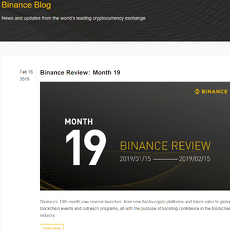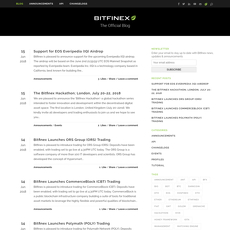Trezor Blog Review
Trezor Blog
blog.trezor.io
Trezor Blog Review Guide: Everything You Need to Know (2025)
Ever get that feeling where you’re drowning in crypto info—charts everywhere, headlines blasting, and you still have no clue where you can actually trust the advice? Let’s face it, with the speed crypto moves, finding a reliable source that actually helps you—not confuses or freaks you out—is basically gold.
So, you’ve heard whispers (maybe even shouts) about Trezor. Their hardware wallet is practically legendary, but have you ever checked their official blog at blog.trezor.io? Is it just a corporate blog, or is there something real there for folks who care about crypto security? Let’s talk about why having a top-tier crypto blog in your bookmarks can make all the difference (and why most sites out there just don’t cut it).
Why You Need Reliable Crypto Blogs (and the Problems With Most)
Here’s the cold reality. Most crypto blogs or news sites barely scratch the surface. And honestly? Some are just clickbait factories. Take a look at the usual suspects:
- Surface-level “news”: One minute you’re excited about a headline, the next there’s zero context. Why does it matter? Who knows!
- Jargon overload: Half the posts are written like you should’ve gotten your PhD in blockchain last week.
- Too much hype or fear: Up, down, memes, panic—do they ever explain what’s actually going on?
- Poor research or dated info: When was the last time they updated that guide? 2021?
It can be easy to get lost, especially if you’re new. Even experienced users feel frustrated wading through low-value content and half-baked hot takes. The end result: wasted time and probably more confusion than when you started.
The Solution: Blogs That Actually Help (Like Trezor’s)
So, what if there was a blog that skipped the fluff and actually helped you move forward? The Trezor Blog promises exactly that. Imagine a crypto site where you get:
- Clear explanations: No guesswork, just actionable info—whether you’re setting up your very first wallet or reviewing advanced privacy features.
- Real updates and security tips: Not just company PR, but analysis that actually prepares you for what’s next.
- Content for both beginners and pros: If you’re new, you can catch up. If you’re advanced, you still get real insights—without being bored.
Honestly, this approach is a breath of fresh air. One study by Statista even found that nearly 60% of new crypto holders said they felt “anxious” about security and understanding best practices. The right blog can literally calm those nerves and keep your funds safer.
Other Resources That Offer Depth
If you want substance, you can also check out deep-dive hubs or curated lists of top resources (like my handpicked crypto blog list—shameless plug, but it’s true). Here’s what sets great blogs apart:
- Detailed guides that explain both the “why” and the “how”—not just the headlines.
- Industry analysis you can actually use, not hype or recycled news.
- Transparency about who’s writing, sources, and updates—a must in the fast-changing crypto world.
So, how does the Trezor Blog measure up? What makes it worth your time, and who should actually read it? I’ve dug into every corner, and I’ve got some honest answers—plus a few surprises about what sets it apart from generic crypto content.
Ready for the nitty-gritty? Curious to see what kind of content the Trezor Blog really offers (and why you might want to start reading it right now)? Trust me, you’re going to want to check out the next section…
What Is the Trezor Blog and Why Should You Care?
If you’re feeling lost with all the conflicting crypto advice out there—or even slightly paranoid about the next big hack—you’re not alone. The Trezor Blog is where the team behind the legendary hardware wallet puts out their knowledge. This isn’t some random aggregator; it’s a resource created by the people who live and breathe crypto security every single day.
It’s way more than just company hype. The Trezor Blog is a hub for news, actionable wallet safety tips, updates on what’s happening both in their products and across the broader crypto scene, plus some seriously smart takes on privacy and industry changes. If you’re security-first, this is worth your clicks.
Who Is the Trezor Blog For?
Ever wondered if a blog caters to you or just hardcore techies? The beauty of the Trezor Blog is its wide net:
- Absolute beginners wanting simple wallet guides
- Advanced crypto users hungry for detailed security strategies
- Trezor owners looking for updates straight from the source
- Anyone obsessed with self-custody and keeping their crypto off exchanges
You’ll find tutorials for newbies right alongside deep looks at vulnerabilities and key industry events—basically, it meets you where you are on your crypto path.
Topics and Content You’ll Find
Wondering what you actually get once you pop in? Here’s a real taste of what the Trezor Blog drops:
- Wallet Security Tips: Real guides for things like setting up passphrases, securing recovery seed phrases, and avoiding common scams.
- Product Updates: Get the scoop on the latest firmware releases (and why updating matters—just ask anyone who missed a crucial patch and paid the price!).
- Educational Guides: Plain-English explainers about secure storage, network attacks, and new crypto privacy features. No endless jargon—just clarity.
- Industry News: They weigh in when big breaches happen or when new attacks trend—adding context, not just headlines.
- Expert Interviews: Want to hear what innovators think about the future of hardware wallets or non-custodial finance? They’ve got you covered with chats and commentary.
I especially appreciate how they break down major global regulatory shifts—like what MiCA means for self-custody in Europe, or how the Ledger “Recover” drama shaped the conversation around privacy. There’s always a practical takeaway.
How Trezor Blog Stands Out
Here’s where it really steps away from the pack: this isn’t a blog designed to push hype or fake “breaking news.” All those pop-up-heavy news dumps just aren’t helpful. Trezor’s approach is about quality, not quantity.
- Insights right from the source: You’re hearing directly from Trezor’s engineering and security pros—not just a marketing intern or republishing of stale press releases.
- Real-world advice: Every security recommendation is something the team uses themselves or has researched heavily.
- No clickbait: When you see an article about a new exploit, it’s there to walk you step-by-step through how to avoid it or respond—not just scare you with drama.
"In a world of endless noise, it’s better to have one voice worth listening to than a thousand shouting over each other."
That’s what the Trezor Blog feels like: less of the hype, more of what actually helps keep your funds safe.
If you’ve ever felt the pain of trying to figure out which crypto blogs are legit, and which ones are just out for clicks, you’re probably already wondering: what separates a truly good crypto blog from the rest? And, honest question—how does Trezor’s content really hold up when you stack it against the best in the business? Stick around — I’m about to break it all down and you’ll want to see exactly where Trezor fits in the world of trustworthy crypto content.
What Makes a Good Crypto Blog? (And How Does Trezor’s Measure Up?)
Let’s be honest: most crypto blogs blur together after a while. You get rehashed news, a lot of speculation, and very little that genuinely makes you want to dig in and keep reading. If you care about your coins and actually want to level up your crypto game, every minute you spend should bring solid value. So, what sets an average blog apart from a must-bookmark resource—especially when talking about Trezor?
Quality Content and Research
I always say, the difference between a good blog and clickbait is in the care. Trezor’s posts aren’t just slapped together. There's plenty of evidence to show they do their homework, backing up claims with links, expert comments, and clear references to sources.
- Clear explanations: Take their security breakdown of hardware wallets vs. software wallets. They didn’t just say “hardware is better.” They walked through specific threat models, referenced real-world exploits, and even addressed user experience concerns. That’s rare in a space where most blogs just parrot whatever’s trending on Twitter.
- No fluff, no fear-mongering: I noticed their guides on common scams focus on practical advice, not just scaring people. They lay out the signs to watch for, actual scam techniques, and actionable checklists. This is way more helpful than generic “don’t trust anyone” posts you’ll see elsewhere.
“In a time of universal deceit, telling the truth is a revolutionary act.” — George Orwell
I think that sums up the need for honesty and depth in crypto. If you crave real research, Trezor's blog is a breath of fresh air.
Niche Focus: Security and Self-Custody
Blogs that pick a lane always deliver more value. Trezor doesn’t try to cover every NFT launch or meme coin. They lock in on self-custody, privacy, and hardware wallet safety—which means you get more depth, more practical use cases, and updates that actually matter if you care about protecting your assets.
- Wallet security explained: Ever read their deep-dive on recovery seeds? They don’t just drop the “write it on paper” advice; they explain why, what attackers could do, and even recent upgrades in seed phrase standards. It's the kind of focused content you don't get from “generalist” crypto news sites.
Is It Beginner-Friendly?
If you’re just starting with crypto, it’s super easy to feel overwhelmed by technical talk. I look for blogs that use plain English, smart visuals, and examples that actually relate to your life. Trezor’s explainers break big concepts—like how cold storage works, or what happens in a network “fork”—down into simple, story-driven steps.
- Real-world examples: For example, their post about phishing doesn’t just define it; it shows screenshots, tells the story of a real user who almost got caught, and finishes with a checklist you can use immediately.
- Feedback and questions: The comment sections are open, so newbies can ask questions and get real answers, not just canned replies.
Design, Language, and User Experience
Ever landed on a crypto blog only to be bombarded by pop-ups, sidebar ads that shout at you, or confusing menus? That's a recipe for an instant back button. Here’s where Trezor usually gets it right:
- Clean layout: No intrusive banners or autoplay videos. The reading experience is focused, so you can actually concentrate on the content.
- Easy navigation: Categories are clear—want security tips, product news, or expert interviews? You find them in seconds.
- Mobile ready: Research shows more than 60% of crypto readers come from mobile. Trezor’s site looks great no matter what device you’re on. No pinching and zooming, no broken links.
- Language that makes sense: No "blockchain maximalist" jargon. Posts feel like you’re having a conversation with a friend who actually knows what they’re talking about.
But here’s the question everyone wants answered—what kind of content do they really publish, and is it just product pitches or the good stuff? The answer might surprise you. And if you’re curious about what you’ll actually find once you visit, just wait for what comes next—you won’t want to miss this sneak peek inside their blog categories and why it matters for every crypto user…
Inside the Trezor Blog: What You’ll Actually Find
Ever wondered what makes some crypto blogs a must-read while others are just “meh”? Let’s peek inside the Trezor Blog and see what pops out—because it does a lot more than just talk about Trezor wallets!
Content Categories
Right off the bat, you’ll notice the Trezor Blog covers several categories that appeal to different kinds of readers. It’s like a playlist made for everyone who gives a damn about crypto security and real news:
- Security Tutorials: Whether it’s step-by-step guides on how to protect your assets or deep explanations of how hardware wallets are built to resist attacks, you’ll find no-nonsense advice that even grandma can follow.
- News Updates: Big hacks? Shocking market shifts? Regulation changes? They don’t just rehash the news—there’s always a Trezor angle or actionable insight about how these updates impact your security.
- Product Features: These aren’t just boring press releases. Think real walkthroughs of major features, interface changes, and even sneak peeks at what’s coming next. Example? Their recent article on Shamir Backup changes had practical screenshots and user-centric commentary.
- Industry Explainers: Complex terms get broken down with analogies, graphics, and examples. Crypto confusion, meet clarity.
- User Stories: You’ll bump into stories from everyday folks securing their first bitcoin or lessons learned from advanced users—proof positive that security is for everyone, not just developers and whales.
- Regulatory Trends: They don’t just report on new EU laws or U.S. compliance; they tie it all back to how it affects your wallet or privacy, often referencing actual legislative texts in plain English.
Frequency and Freshness
Nobody likes a stale crypto blog. Trezor keeps things fresh: you’ll spot new posts every couple of weeks (sometimes faster when the industry explodes with news). I noticed big updates often drop right after major industry news—like their immediate security tips after high-profile exchange hacks. But it’s not only about chasing headlines. There’s also a solid mix of evergreen content—guides on private key recovery and threat modeling—that stays relevant month after month.
One recent study from Statista revealed that people are far more likely to read and trust security-focused updates after news breaks about crypto thefts. Trezor clearly knows this—they time their articles just right.
Expertise, Originality, and Trustworthiness
Here’s what really makes the Trezor Blog stand out for me: transparency and depth. Most posts are penned by their internal team—engineers, cryptography experts, support pros—sometimes bringing in respected guest writers. You’ll spot names and bios, not just “admin.” They back up claims with industry studies, audit reports, and often link to open-source code or reference guides for the true geeks.
“Distrust and caution are the parents of security.” – Benjamin Franklin
That quote perfectly captures what sets them apart. The Trezor Blog doesn’t sugarcoat risks or offer blind optimism. They don’t shy away from sharing hard truths or even admitting when something didn’t go perfectly with their own product. Real trust is built with honesty and knowledge, not just glossy marketing. You see that here—no fluffy how-to-buy-crypto guides just to chase views.
There’s also a cool streak of original commentary: predictions about coming privacy threats, analysis of security research, myth-busting about crypto fear-mongering, and a few strong “here’s our take” editorials.
Compared to Other Crypto Blogs
If you’ve hopped around my personal favorites, you’ll notice the style here leans less towards hype and meme culture and more toward hands-on learning and real user safety. While Trezor’s competitors might post frequent “top ten coins” lists or quick news bites, Trezor focuses on actionable content. Why does this matter? If you care more about keeping your assets safe (and less about trading the latest memecoin pump), this blog has you covered.
- Trezor Blog: Security-first, technically solid, always transparent.
- Other Top Crypto Blogs: Some are broader (think industry gossip, investor trends, or market stats), others hyper-focus on altcoins or exchanges. It really depends what you want most—expertise or variety.
You know how you sometimes wish a single blog could answer every question about wallets, hacks, privacy, and crypto law? You’ll get a good chunk of that here, but, let’s be honest, there’s still more you probably want to know before hitting that “follow” button.
Ever wondered if the Trezor Blog is only about wallet updates, or if beginners can truly understand their posts? Let’s clear up those common questions—because the answers might just surprise you. Stick around for the next part!
FAQ: Everything You Need to Know Before Following Trezor Blog
I know what it’s like when you hear about yet another crypto blog—especially one connected with a big brand like Trezor. The questions start flying: Is it just marketing fluff? Will it help beginners? How’s it stack up to all the third-party blogs? And how often should you actually expect something new? I get these questions a lot, so let’s get right into the real answers, straight and simple.
Is the Trezor Blog Only for Trezor Product Updates?
This is a question I hear all the time, and it’s a fair one. You might think the Trezor Blog is just a megaphone for their latest firmware releases or product announcements—but that’s really not the case. Sure, you’ll find timely updates about new Trezor features and fixes (obviously, they want their users to stay safe), but take a quick look at posts over the last year and you’ll spot deep dives on wallet safety, crypto privacy, and industry news that affects hardware wallet users in general.
- Recent posts break down upgrades to Bitcoin security (like what Taproot actually means for hardware wallets).
- They've published security tutorials that apply even if you don’t own a Trezor, focusing on best self-custody practices versus hot wallets.
- You'll sometimes see commentary on regulatory changes, privacy debates, and even incident response guides relevant to all crypto holders.
So, if you’re worried it’s just a stream of product promo—don’t be. Their writers know the crypto community is paying attention, and they step up with broader content pretty often.
Can Beginners Learn from Trezor Blog?
If you’re just starting out, it’s easy to feel overwhelmed by crypto slang and complex security advice. But Trezor knows this. Some of my favorite pieces on their blog are ultra-clear explainers that break down things like “What is a seed phrase?”, “Why hardware wallets matter,” or how to safely manage your recovery backup. You’ll notice the tone is approachable, and posts often use simple language, plenty of illustrations, and even step-by-step walkthroughs. This is the kind of content that helps demystify all those buzzwords you keep hearing in the crypto world.
According to Statista stats, a big chunk of new crypto users are younger and less experienced—meaning there’s a real need for resources that don’t assume deep tech knowledge. Trezor’s blog is right at home here.
How Does Trezor’s Advice Compare to Third-Party Crypto Blogs?
Here’s where things get interesting. Because Trezor is both a hardware wallet provider and an educator, you get official advice backed by their internal security team. This carries a lot of weight for Trezor users and anyone interested in bulletproof security standards. But let’s be honest: third-party blogs—especially ones I recommend on my site—offer different flavors.
- On Trezor Blog, expect detailed explainers on self-custody, first-party case studies, and updates straight from the engineers—less hype, more how-to.
- Blogs listed at Cryptolinks.com take on a wider range of topics, from market analysis to altcoin trends, with voices outside of any one company.
- For deep product comparisons or market-wide commentary, third-party blogs sometimes go places official sites won’t (think: heated NFT debates or open-source wallet rivalries).
Bottom line: Trezor Blog gives you the perspective of people making the hardware. When you want a wider angle, tap into the mix I’ve handpicked for you.
How Often Is the Trezor Blog Updated?
Frequency matters. After all, what’s the point of following a blog that only updates when there’s a major product launch? Trezor typically sticks to a steady flow of new articles, especially when there’s something big happening in crypto security or regulation. Posts usually land a few times per month, mixing timely updates with evergreen guides that stay relevant for months or even years.
If a major security issue hits the headlines, you’ll often see a Trezor response within days (sometimes faster). But there’s also a focus on longer reads that help you level up your skills long-term, which is great if you’re after quality, not just quantity.
Where Else Can I Find Good Crypto Blog Content?
You don’t have to stop at Trezor Blog—trust me, the best way to stay ahead in crypto is to keep your feed full of different voices and perspectives. That’s exactly why I’ve built and frequently update my own lineup of top crypto blogs at Cryptolinks.com. Each blog I recommend there is vetted for in-depth analysis, clarity, transparency, and—most importantly—reliability. Whether you’re into DeFi, security, market trends, or niche altcoins, I’ve got you covered with over 35 carefully ranked crypto blogs for every kind of reader.
Want to learn more about choosing the right crypto blog and what really sets each one apart? Check out the full guide on Cryptolinks.com for a head start—especially if you want more than just wallet security content.
Now, you might be wondering: after learning all this, is the Trezor Blog truly worth your precious time and bookmark space? There’s one more section coming up where I’ll share my honest verdict—and reveal a few personal tricks for getting the most out of every crypto blog you follow. Curious to know how Trezor stacks up and what other sites should make your shortlist? Don’t miss what’s next…
Final Thoughts: Is the Trezor Blog Worth Your Time?
So here’s the bottom line—does the Trezor Blog actually live up to the hype, or is it just another marketing megaphone wrapped in crypto lingo?
Who Should Bookmark the Trezor Blog?
If you’re someone who’s serious about hardware wallet security or just trying to figure out how not to lose your crypto to some phishing scam, this blog is absolutely made for you. Whether you’ve just cracked open a Trezor wallet for the first time or you’re the go-to crypto safety friend in your circle, you’ll find value here.
One of my favorite things? The articles aren’t just for Trezor fans. Plenty of posts break down real-world events—like recent wallet hacks or new regulations—into actionable steps for anyone in crypto. When the Ledger Connect Kit vulnerability went public in late 2023, for example, Trezor Blog had a straightforward explainer about how their devices weren’t affected and what every user should watch for, without making it just about Trezor products. That’s the kind of balanced transparency I wish more brands had.
Other Blogs to Keep on Your Radar
I’m a big believer in not putting all your eggs in one basket—especially in crypto, where one viewpoint isn’t enough. So yes, keep Trezor Blog in your bookmarks, but also check sites with fresh voices or different specializations. Personally, I like rotating between:
- Bitcoin Magazine for deep dives on Bitcoin fundamentals
- Decrypt for broader crypto news and opinion
- And of course, my curated favorites on Cryptolinks.com where I weed out the noise and highlight quality blogs, tutorial hubs, and research portals
Think of it as building your own feed of reliable sources so you’re never behind on anything important—whether it’s an upcoming Ethereum hard fork or a sneaky new malware campaign.
What I Like (and Where It Could Improve)
Let’s keep it real. Here’s what stands out about the Trezor Blog:
- Expertise you can actually check: Almost every post is authored by someone with clear experience—many times direct Trezor team members or reputable guest experts. They don’t hold back on references; sometimes they’ll even cite research, like when they compared seed phrase lengths in relation to wallet security (yes, that notorious BIP-39 argument).
- Clarity over jargon: Even tech-heavy entries explain cryptography and wallet functions with simple language. If you’ve ever tried to understand multisig wallets or transaction signing, you know how helpful clear writing is.
- Transparency: They’re pretty good about calling out both the risks and the efforts to improve, whether it’s disclosure of vulnerabilities or industry trends in wallet upgrades. This kind of honesty actually builds trust.
Still, a few upgrades would take the blog next level:
- More community Q&A: There’s not much space for reader questions or a direct feedback loop. I’d love to see more AMA-style posts or threads—bringing real user concerns into the spotlight.
- Even broader topics: Most posts focus on self-custody and wallet updates. Sprinkling in more on privacy coins, NFT security, or crypto psychology (like what The Block does for market behavior) would broaden the appeal even more.
Final Word
Crypto never sits still. The technology’s always evolving, scams get smarter, and regulations tend to pop up faster than you can say “seed phrase.” Your best defense? Stay curious and keep learning from quality sources.
The right blogs—Trezor’s included—make the journey not just safer, but way less intimidating. If you care about protecting your coins and want well-explained, up-to-date insights straight from the wallet-makers themselves, you can’t go wrong with Trezor Blog.
Just remember: balance is key. Bookmark the standouts, keep your feed diverse, and always ask questions. That’s how you’ll actually stay one step ahead in crypto. Stay safe, stay sharp, and never stop learning!













